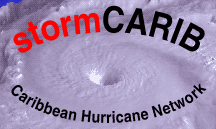
 |
Press Release |
|
|
Colorado State University
For Immediate Release Contact: David Weymiller
May 16, 2001 (970) 491-6432
dweymiller@ur.colostate.edu
NEXT COLORADO STATE HURRICANE FORECAST LIKELY TO CONTINUE AVERAGE SEASON,
ALTHOUGH FACTORS COULD RAISE STORM NUMBERS
FORT COLLINS--While hurricane forecaster William Gray and his
colleagues at Colorado State University are satisfied with their April
forecast update, any possible changes in the June 7 forecast may slightly
increase the number of storms.
In a mid-May interview, Gray held out a slight chance that April's
numbers - 10 named storms, six hurricanes and two major hurricanes - might
go up.
"There's perhaps a little greater chance of raising than lowering
those forecast numbers, but there's also a good chance we'll just keep it
the same," he said.
The causes of uncertainty are "mixed climate signals," according to
Gray, professor of atmospheric science at Colorado State.
Rainfall is moving into the Sahel region of West Africa in typical
seasonal patterns at this point, he said. In the Atlantic, sea-surface
temperatures are warm and a high-pressure formation called the Azores Ridge
is relatively weak. Both are positive indicators of hurricane formation.
On a larger scale, stratospheric winds near the equator called the
Quasi-Biennial Oscillation, or QBO, are blowing from an easterly direction,
inhibiting hurricane formation.
But the big question remains just how warm the eastern equatorial
Pacific water temperatures are going to become.
"This year, we're very confident we're not going to get an El Niņo
like the one that occurred in 1997," said Gray, referring to events that led
to one of the Colorado State team's worst forecasts. When an east Pacific
warm equatorial water mass (El Niņo) is set up, tropical Atlantic hurricane
activity almost always is reduced.
But the team's not confident what degree of warming will occur, and
Gray said the degree of eastern Pacific warming is probably the biggest
single variable in the forecast.
Interestingly, Gray admitted that the initial forecast issued in
early December 2000, which called for nine named storms, five hurricanes and
two major (Saffir-Simpson 3-5) hurricanes, and the April update, which
called for 10 named storms, six hurricanes and two major hurricanes,
involved debate about the number of major storms. Some team members thought
the season would bring three. Gray said they will carefully re-examine this
question for the early June forecast.
The Colorado State prediction team has advanced a theory that an
ocean current called the Atlantic Ocean thermohaline circulation system,
which includes the Gulf Stream, carries salty, relatively warm water to the
North Atlantic. A stronger thermohaline circulation doesn't necessarily
spawn more named storms overall but does produce more major, landfalling
hurricanes along the East Coast and peninsular Florida.
A more active, stronger thermohaline system has been observed
between 1995 and 2000, during which 23 major storms have occurred in the
Atlantic Basin. Only three, or about one in seven, have made landfall.
However, in the last century, 73 major storms have come ashore,
approximately one in three. Gray points out that, in the last six years, the
East Coast has been largely protected by upper-level troughs that produce
southwesterly winds that "recurve" most major storms, forcing them into a
clockwise curve that leads out into mid-ocean.
"In the next decade or two, we think we're going to get landfalling
hurricane activity more typical of the 1930s through the 1960s," he said.
"We think we're in an era of major, landfalling storms (on the East Coast of
the United States.)"
Another area whose good fortune may be ending is peninsular Florida
- essentially the state minus the western panhandle. Gray finds it "amazing"
that in the past 35 years only one major hurricane (Andrew in 1992) made
landfall. In the previous 35-year period (1931-1966), he points out, 11
major hurricanes made landfall.
Similarly, in the past 50 years, the Florida peninsula encountered
only three major landfalling hurricanes. During the previous half-century
(1900-1949), 15 came ashore in that state.
"There were a variety of climate factors reducing peninsular Florida
storms the last 35 years, but some of it was due to just plain luck," Gray
said. Because he believes more storms will strike the state, he estimates
that about 10 times as much hurricane-caused damage will occur in the next
35 years as what has taken place in the past 35 years.
Gray's team will issue the next official forecast update on June 7.
"I think there's a possibility we might raise (storm numbers in) our
early June forecast somewhat, but we reserve the right to look at all the
data that comes in and discuss it at length before making any decisions," he
said.
Gray's Website containing the April 6 forecast update and other materials is
located at http://tropical.atmos.colostate.edu/forecasts/index.html.
Back to Homepage